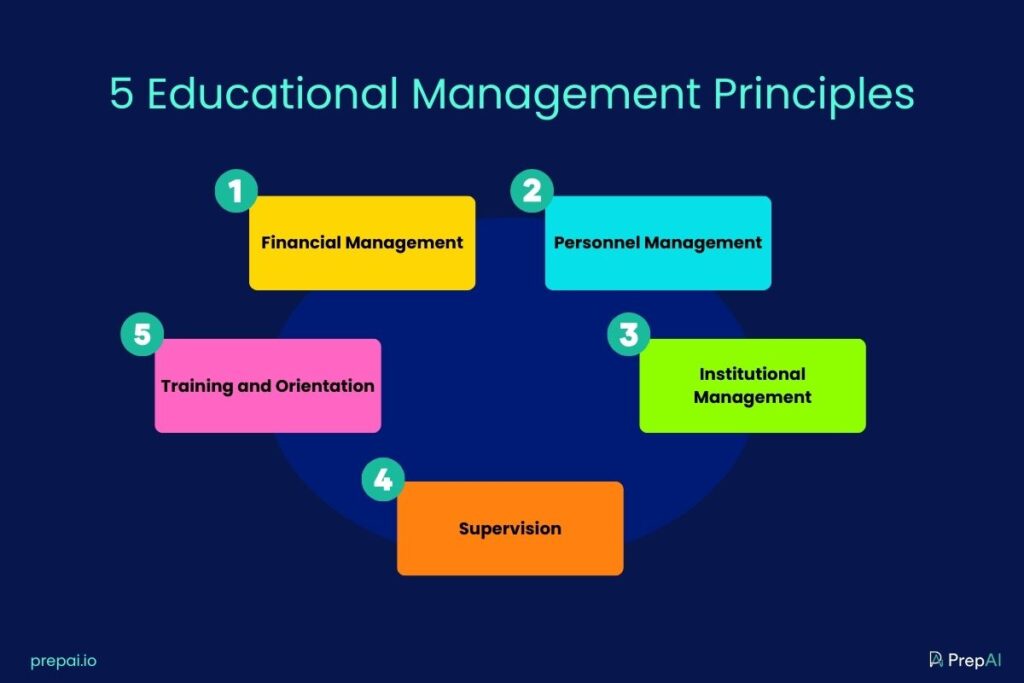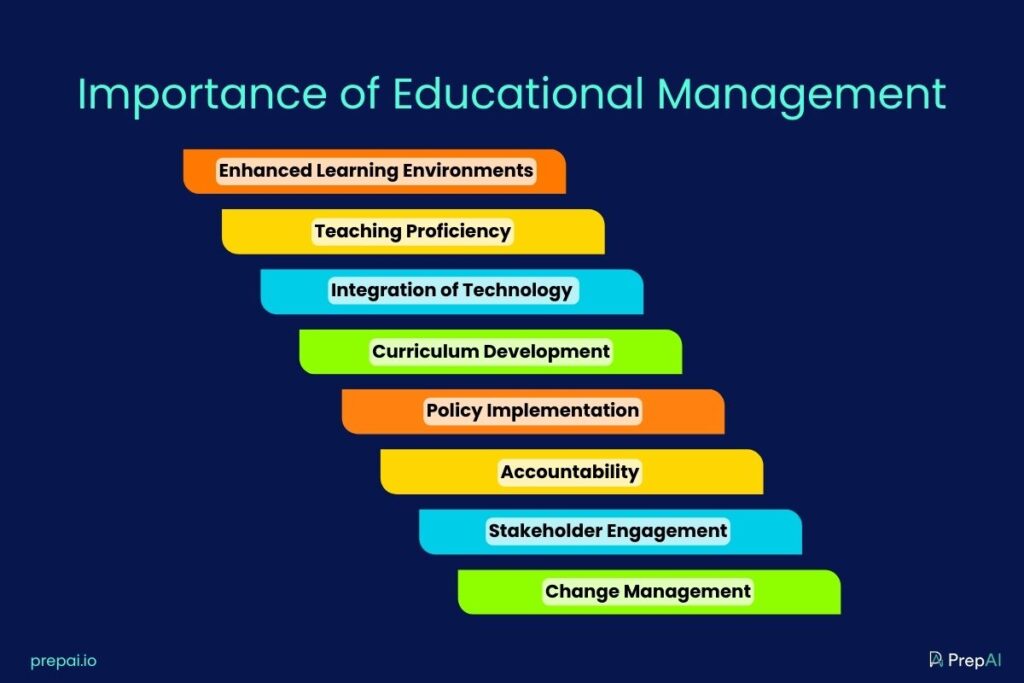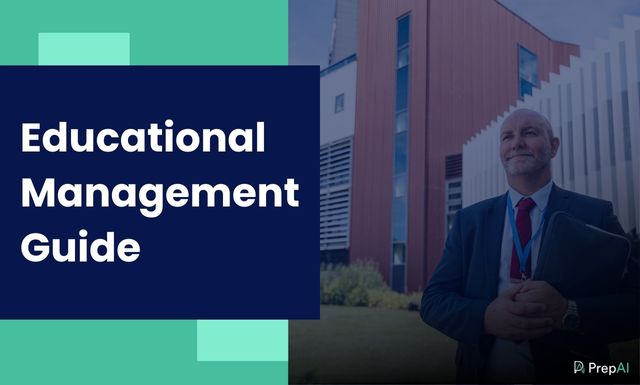Robert Kreitner, a distinguished personality in management, defines management as a problem-solving process done to effectively achieve the organizational objectives via efficient use of resources in a changing environment.
And, as an EdTech service provider, we couldn’t agree more!
Education is one of the most diverse and agile industries where the environment is constantly changing and decision-makers at every level have to take extremely cautious, calculated, and well-planned decisions. Further, every educational institution requires efficient and reliable management to ensure productive working and optimal organizational functioning.
Also called educational management, this set of activities aims at the “operation” of management functions in educational institutions. But, there is no set definition of the term, as the roles and evolution of educational management vary across disciplines and educational institutions.
Here, we discuss what educational management is, explore the challenges it encounters, and share some solutions for them.
So, take a thorough read and hope this contributes to leveling up your educational management skills with the industry-best practices.
What Is Educational Management?
Educational management is the regular process of administrating and organizing functional educational setups. It explains every person involved in the system – “What needs to be done and the manner in which it needs to be done”. Also, every person doing a job must understand the indications that show whether the task given to them is successfully completed or not.
Hence, the scope of educational management is quite wide and aims at bringing society and education together, and comprises of activities such as:
- Setting, developing, and running the basic infrastructure related to education, such as schools, colleges, universities, libraries, museums, hostels, etc.
- Maintaining academic records
- Appraising student achievements and monitoring the student activities
- Managing inventories related to supplies, such as stationery, books, hardware, digital equipment, building infrastructure, lab equipment, etc
- Preparing schedules for teaching, training, exhibitions, seminars, presentations, etc
- Ensuring discipline, work synchronization across all the departments and educational authorities
- Prepare syllabi for classes, tests, internal evaluation, final exams, etc.
- Managing funds, budgets, community services, and the overall health of every person in the system
Educational Management: Principles, Problems, and Solutions

1. Financial Management
Managing the budget, investments, fees, operational costs, salaries, recreational activities, alumni meet-ups, functions, and other paid services on the campus – there are numerous umbrella activities under financial management.
Education management focuses on managing all the aspects of accounting and financial management in an educational institution that have a direct or indirect bearing on the overall functioning. The educational managers have to analyze the constituent elements of budget and cost management and identify the major issues related to them.
They need to manage, process, and analyze the cost data and project future steps to keep the costs controlled.
Problems in Financial Management
While it seems easy at first, managing finances in an educational institution is a daunting task that requires a thorough understanding of financial rules and regulations. Further, the educational manager has to identify the ways of bringing structural changes in the accounting system.
Also, there are numerous other management tasks that need attention on a daily basis, and dedicating time to learning the minutes of financing is impossible.
Solutions
- Investing in financial management software or tools for organizational budget management can not only reduce the burden but also make the job easier, more reliable, and less prone to errors.
- Hiring the right talent to manage the basic tasks and operating the budget management system will also ensure better delegation of duties.
2. Personnel Management
Managing the people constituting the educational institution is also an important task and requires a fair balance between the personal needs of employees and the organization.
Some of the common activities involved in it are:
- Discipline
- Trade union relation management
- Training the personnel for professional growth
- Performance assessment and reporting
- Managing hiring, firing, and transfers
- Placements and promotions
- Wage and salary management
- Ensuring adherence to the job responsibilities
Finally, education management also aims at personnel welfare via housing, health and safety, education of their children, pensions or policy plans, and food & recreation incentives.
Problems in Personnel Management
Many times the managers lack the qualities of head and heart to manage the personnel which leads to inadequate attention paid to the personnel or staff. Further, staff management requires a thorough understanding of the human relations approach, such as sympathetic listening, friendly persuasion, resilient yet flexible attitude to the adherence to rules and regulations, etc.
Some other problems in personnel management are:
- The narrowness of the scope of staff management activities
- Absence of thorough and robust personnel policies
- Inadequate, inaccurate, or unreliable personnel records
- Not involving employees in decisions that affect them
Solutions
- Create personnel management policies, regulations, and charters with the senior management and staff members
- Ensure routine checking of staff sentiment
- Take feedback from staff in all the departments and work on the problems gathered in it
3. Institutional Management
Managing an institute is a whole lot of trouble, especially when you are looking at large educational setups such as universities and multiple departments with a campus of their own. Right from the staff to hardware, infrastructure to maintenance and beautification to new constructions – the number of activities in institutional management is astonishing.
Major categories of all the activities involved in institutional management are:
- Staff management and delegation of institute management activities among the members
- Managing, maintaining, and ensuring the physical facilities
- Investing in an inventory management system and record-keeping system
- Interpersonal relationship management
- Participatory management
- Managing the business aspects of institute management
- Institutional organization
Problems in Institutional Management
- Having lack of proper financial means
- Lack of leadership vision in the educational manager leads to a poor or redundant delegation of duties
- Facing administrative challenges in certain domains, such as research and development and managing the non-formal aspects of education
Solutions
- Taking feedback from the management board to identify the issues, and pain points in institutional management
- Investing in the right technology to support and streamline the operations and eliminate the errors
- Opting a transparent management approach for ensuring confidence-based management
4. Supervision in Education – Academic and Administrative
Supervision is an extensive function that extends from the highest level to the lowest level in an organization and requires a thorough “direction, instead of control” for producing the best results.
In the best-case scenario, the organization will have a low supervisor-to-operator ratio and every supervisor guides the operators, with a problem-solving and coordinating attitude.
Now that we have covered the supervision in administration, we need to address the supervision in academics.
Educational management in academics involves a number of activities, some of which are as follows:
- Organizing exams, tests, co-curricular activities, placement events, workshops, seminars, presentations, competitions, etc.
- Formulating and improving the evaluation methodologies for practical or skills assessment, such as investing in smart EdTech tools, like PrepAI
- Catering to the remote learning needs
- Having proper libraries, journal memberships, learning management systems, and interactive learning software
Problems in Supervision
- Lack of right software or right talent to use or make the most of them
- Not improving the internal assessment policies and means
- Misinterpreting supervision as controlling the subordinates
- Mindless delegation of supervision duties leading to clashes and interpersonal issues
Solutions
- Have clear-cut leadership goals and supervision goals and ensure that every person adheres to them
- Taking professional help in choosing the right software for your academic needs
- Making internal assessments better and more relevant to modern times by using smart educator solutions such as PrepAI that make evaluation better, more reliable, less time consuming, and more relevant to the current times
- Organizing personnel training events so that they can learn the industry-best practices for supervision in various settings
5. Training and Orientation of Educators
As important it is to educate and train the students with the best resources, it is essential to work on the skills and professional growth of the educators as well. Organizing activities, conferences, events, seminars, and presentations for training and improving the staff also falls under educational management.
Doing so will significantly improve the quality of education and motivate the educators to opt for better and new ways to deliver lectures. When the lecturers know new things, they are highly motivated to share them with their students and this leads to better student engagement in the class.
Problems in Training and Orientation of Educators
- Lack of financial means to organize such activities
- Lack of willingness in the staff to attend such meetups
- Poor organization and conduction of training sessions
- Poor quality of training material
- Training fatigue in the staff because of continuous training sessions
Solutions
- Always opt for the most engaging and motivating trainers
- Invest in quality, instead of quantity to ensure better results
- Opt for smart EdTech tools like PrepAI that empower teachers with automation in education
- Take feedback from the teachers to see whether they find these sessions fruitful or not
- Make staff evaluation and performance an inherent part of promotion and incentives
Importance of Educational Management
Education management is not to be taken lightly, as it affects almost every aspect of the institution. It influences the structure and management of educational establishments in the following ways:

Enhanced Learning Environments
In today’s world, schools, colleges, and universities are expected to be diverse, inclusive, and safe for students from different backgrounds, cultures, and regions. The teaching modules and tools should provide a level playing field for students to gain knowledge and explore their strengths. Instead of offering a standard one-size-fits-all setup, educational institutions can enhance learning by offering personalized solutions. This requires efficient management and clear policies.
Teaching Proficiency
Teachers need to be up to date about the latest changes in their fields. They also need to embrace technology and use it as a part of their classroom and administrative tasks. Educational management also covers the resources provided to teachers to enhance their skills and knowledge. Be it regular teacher training sessions, seminars, or access to new technology, the institution should ensure that teachers continue to hone their skills and become proficient.
Integration of Technology
EdTech has gained prominence as we can no longer separate education and technology. Tech tools have a lot to offer to educational institutions. However, cohesive integration of technology into the classrooms or non-teaching activities requires proper planning and a clear understanding of what is necessary and what the objectives are. That’s where educational managers prove their worth by aligning the requirements with the vision and goals and finding the right EdTech partner to convert the ideas into actions.
Curriculum Development
The principles of educational management also impact the curriculum development in the institution. Though the school or college has to follow the guidelines of the authorized regulatory boards, it has the autonomy to add more elements/ skills/ courses/ etc. to the curriculum. An efficient education manager will assist teachers in developing a holistic and comprehensive curriculum that benefits students in multiple ways.
Policy Implementation
Educational management is necessary to develop and implement various policies governing the establishment. It covers an array of factors like regulatory compliance, curriculum, student safety, personnel safety, transparency, communication, teaching methodologies, testing modules, and much more. From anti-bullying policies to cheating and plagiarism, how the educational institution handles these issues depends on the educational managers and the policies.
Accountability
All educational institutions are not the same. Why do some schools or colleges have a greater reputation than others? Better educational management is the answer. Quality standards are crucial for a school or college to stand apart from the competition. The same can be said for accountability and taking responsibility to fix things. These aspects come under educational management and can determine the future of the institution. A quality-minded and accountable educational establishment will have a better and brighter future, as will the students studying there.
Stakeholder Engagement
Educational management also includes stakeholder engagement. It’s not just the teachers and students who need to be involved. The administrative staff, the helping staff, parents, the community (region/ city), investors, etc., also have a role in how the institutions function over time. An experienced educational manager will take input from all parties to get a 360-degree view of the situation and come up with solutions that keep the stakeholders engaged and emotionally connected to the place.
Change Management
What is educational management all about? Does it also include how the school/ college handles new developments? Absolutely! Innovation, creativity, and change are necessary for an establishment to stay relevant today. However, deciding which changes to adopt and which ones to ignore is vital. Educational managers determine these aspects by finding a balance between innovation, consistency, and sustainability.
Management Practices in Education
The core educational management principles focus on understanding the concept of educational management and how it affects the institution. They also include other elements like communication, coordination, control, evaluation, power and authority, etc.
Understand Educational Management
Educational management is not just the job of the manager assigned to the role. It is not limited to the top management or high-level decision-makers. Educational management brings together the leadership, teachers, administrators, and other stakeholders who will be impacted by the decisions made. It is where the vision, mission, goals, ideologies, policies, and actions should align to provide educational excellence to students and bring a good name to the institution.
The Art and Science of Management
Management is a blend of art and science as it requires several individuals to work together as a team. The purpose of educational management is to reduce or eliminate friction within teams and encourage efficiency. Delegation, authority, accountability, implementation, innovation, etc., are a part of it. For example, educational management should bridge the gap between theory and reality when developing policies and implementing them.
Effective Communication
How an educational institution handles communication can determine its success in the long run. Transparent and two-way communication builds trust between the institution and stakeholders. It brings everyone on the same page and creates a common goal for them to achieve. It also highlights areas that need extra focus to correct the wrongs. Choosing and maintaining multiple channels of communication is also a part of educational management.
Controlling and Correcting
Power and authority are a part of educational management. There will be leaders and supervisors as well as subordinates and staff (personnel) who implement the decisions made by the higher-ups. Assertive control is essential to implement the policies and decisions in day-to-day activities. Similarly, corrective steps are important to reduce mistakes and avoid them from being repeated. This could be in any area – from student fights to resource allocation.
Coordinating and Directing
Educational institutions are not a one-person show. With multiple parties involved, how the educational managers coordinate everything can directly influence the results. For example, the decisions made by the leadership have to be properly communicated with others. There should be a reliable sequence of steps to follow when addressing an issue. The staff should work together to achieve the common goals (which benefit the establishment). For all this to happen as a seamless cycle, there should be proper direction, guidance, motivation, and rewards.
Continuous Evaluation
What principles of educational administration and planning are fundamental to the management process? Continuous evaluation of the process and making corrective changes or improvements to increase overall efficiency and performance. While planning and implementation are one part of the process, the best way to achieve long-term consistency and success is by monitoring the impact of these strategies and making the necessary changes on time. For example, if an anti-bullying policy is not helping students, it needs to be improved and altered accordingly. Additionally, the focus should not be on reducing the number of bullying cases but should address the root cause.
Unlocking Success in Educational Management: Consistency and Dynamism
By now you might have realized that educational management is an ongoing process with lots of activities and responsibilities in it. So, successful educational management has its roots in a proper combination of consistency and dynamism.
Not only do the educational managers have to be consistent in their efforts, leadership, managing duties, and learning, but they also have to be dynamic to ensure that all the activities run in parallel, properly.
With an effective analysis of the principles of educational management, we aim at sharing the industry-best knowledge with education stakeholders globally. This way, they can understand the best management practices and approach for managing in whatever role and designation they are!




